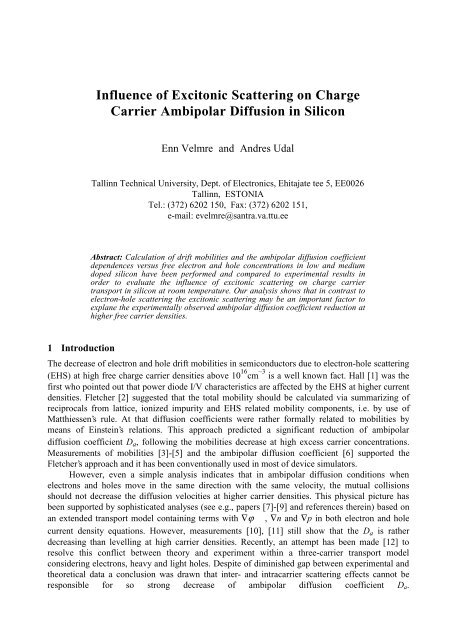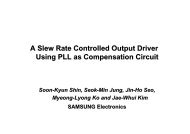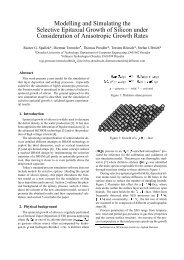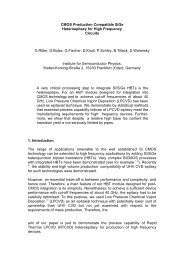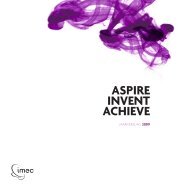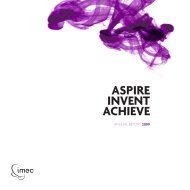Influence of Excitonic Scattering on Charge Carrier Ambipolar ... - Imec
Influence of Excitonic Scattering on Charge Carrier Ambipolar ... - Imec
Influence of Excitonic Scattering on Charge Carrier Ambipolar ... - Imec
Create successful ePaper yourself
Turn your PDF publications into a flip-book with our unique Google optimized e-Paper software.
1 Introducti<strong>on</strong><br />
<str<strong>on</strong>g>Influence</str<strong>on</strong>g> <str<strong>on</strong>g>of</str<strong>on</strong>g> <str<strong>on</strong>g>Excit<strong>on</strong>ic</str<strong>on</strong>g> <str<strong>on</strong>g>Scattering</str<strong>on</strong>g> <strong>on</strong> <strong>Charge</strong><br />
<strong>Carrier</strong> <strong>Ambipolar</strong> Diffusi<strong>on</strong> in Silic<strong>on</strong><br />
Enn Velmre and Andres Udal<br />
Tallinn Technical University, Dept. <str<strong>on</strong>g>of</str<strong>on</strong>g> Electr<strong>on</strong>ics, Ehitajate tee 5, EE0026<br />
Tallinn, ESTONIA<br />
Tel.: (372) 6202 150, Fax: (372) 6202 151,<br />
e-mail: evelmre@santra.va.ttu.ee<br />
Abstract: Calculati<strong>on</strong> <str<strong>on</strong>g>of</str<strong>on</strong>g> drift mobilities and the ambipolar diffusi<strong>on</strong> coefficient<br />
dependences versus free electr<strong>on</strong> and hole c<strong>on</strong>centrati<strong>on</strong>s in low and medium<br />
doped silic<strong>on</strong> have been performed and compared to experimental results in<br />
order to evaluate the influence <str<strong>on</strong>g>of</str<strong>on</strong>g> excit<strong>on</strong>ic scattering <strong>on</strong> charge carrier<br />
transport in silic<strong>on</strong> at room temperature. Our analysis shows that in c<strong>on</strong>trast to<br />
electr<strong>on</strong>-hole scattering the excit<strong>on</strong>ic scattering may be an important factor to<br />
explane the experimentally observed ambipolar diffusi<strong>on</strong> coefficient reducti<strong>on</strong> at<br />
higher free carrier densities.<br />
The decrease <str<strong>on</strong>g>of</str<strong>on</strong>g> electr<strong>on</strong> and hole drift mobilities in semic<strong>on</strong>ductors due to electr<strong>on</strong>-hole scattering<br />
(EHS) at high free charge carrier densities above 10 16 cm –3 is a well known fact. Hall [1] was the<br />
first who pointed out that power diode I/V characteristics are affected by the EHS at higher current<br />
densities. Fletcher [2] suggested that the total mobility should be calculated via summarizing <str<strong>on</strong>g>of</str<strong>on</strong>g><br />
reciprocals from lattice, i<strong>on</strong>ized impurity and EHS related mobility comp<strong>on</strong>ents, i.e. by use <str<strong>on</strong>g>of</str<strong>on</strong>g><br />
Matthiessen’s rule. At that diffusi<strong>on</strong> coefficients were rather formally related to mobilities by<br />
means <str<strong>on</strong>g>of</str<strong>on</strong>g> Einstein’s relati<strong>on</strong>s. This approach predicted a significant reducti<strong>on</strong> <str<strong>on</strong>g>of</str<strong>on</strong>g> ambipolar<br />
diffusi<strong>on</strong> coefficient Da, following the mobilities decrease at high excess carrier c<strong>on</strong>centrati<strong>on</strong>s.<br />
Measurements <str<strong>on</strong>g>of</str<strong>on</strong>g> mobilities [3]-[5] and the ambipolar diffusi<strong>on</strong> coefficient [6] supported the<br />
Fletcher’s approach and it has been c<strong>on</strong>venti<strong>on</strong>ally used in most <str<strong>on</strong>g>of</str<strong>on</strong>g> device simulators.<br />
However, even a simple analysis indicates that in ambipolar diffusi<strong>on</strong> c<strong>on</strong>diti<strong>on</strong>s when<br />
electr<strong>on</strong>s and holes move in the same directi<strong>on</strong> with the same velocity, the mutual collisi<strong>on</strong>s<br />
should not decrease the diffusi<strong>on</strong> velocities at higher carrier densities. This physical picture has<br />
been supported by sophisticated analyses (see e.g., papers [7]-[9] and references therein) based <strong>on</strong><br />
an extended transport model c<strong>on</strong>taining terms with ∇ϕ , ∇n and ∇p in both electr<strong>on</strong> and hole<br />
current density equati<strong>on</strong>s. However, measurements [10], [11] still show that the Da is rather<br />
decreasing than levelling at high carrier densities. Recently, an attempt has been made [12] to<br />
resolve this c<strong>on</strong>flict between theory and experiment within a three-carrier transport model<br />
c<strong>on</strong>sidering electr<strong>on</strong>s, heavy and light holes. Despite <str<strong>on</strong>g>of</str<strong>on</strong>g> diminished gap between experimental and<br />
theoretical data a c<strong>on</strong>clusi<strong>on</strong> was drawn that inter- and intracarrier scattering effects cannot be<br />
resp<strong>on</strong>sible for so str<strong>on</strong>g decrease <str<strong>on</strong>g>of</str<strong>on</strong>g> ambipolar diffusi<strong>on</strong> coefficient Da.
Obviously some new physical effects should be implemented to explane the Da behaviour. In<br />
this paper we examine electr<strong>on</strong> and hole scattering <strong>on</strong> Wannier-type excit<strong>on</strong>s as a additi<strong>on</strong>al<br />
scattering mechanism to remove the above-menti<strong>on</strong>ed discrepancy.<br />
2 Model descripti<strong>on</strong> and calculati<strong>on</strong> results<br />
Present analysis is based <strong>on</strong> our previously published [13] charge carrier low-field transport and<br />
mobility model, developed by use <str<strong>on</strong>g>of</str<strong>on</strong>g> Kohler’s variati<strong>on</strong>al principle soluti<strong>on</strong> <str<strong>on</strong>g>of</str<strong>on</strong>g> Boltzmann transport<br />
equati<strong>on</strong>. In additi<strong>on</strong> to c<strong>on</strong>venti<strong>on</strong>al lattice, i<strong>on</strong>ized impurity and inter- and intracarrier scattering,<br />
the scattering <str<strong>on</strong>g>of</str<strong>on</strong>g> free carriers <strong>on</strong> Wannier-type excit<strong>on</strong>s is taken into account assuming spherical<br />
parabolic bands for both electr<strong>on</strong>s and holes. Excit<strong>on</strong>s are c<strong>on</strong>sidered as positr<strong>on</strong>ium-like particles,<br />
which can scatter free carriers similar to neutral impurity atoms [14]. The relevant scattering terms<br />
e ex<br />
drs − *<br />
h ex<br />
and drs − *<br />
* ee * hh<br />
c<strong>on</strong>tribute to the determinant G elements Γrs<br />
and Γrs<br />
[13] like i<strong>on</strong><br />
e i<br />
scattering terms drs − *<br />
h i<br />
and drs − *<br />
do.<br />
For excit<strong>on</strong> density descripti<strong>on</strong> we propose two sub-models. The first (see Fig.1) is based <strong>on</strong><br />
thermodynamics <str<strong>on</strong>g>of</str<strong>on</strong>g> a mixed gas <str<strong>on</strong>g>of</str<strong>on</strong>g> free electr<strong>on</strong>s, holes, and excit<strong>on</strong>s. In this "chemical picture"<br />
the mass acti<strong>on</strong> law is written as nex = n ⋅ p K(<br />
T,<br />
γ ) , where the chemical mass equilibrium<br />
c<strong>on</strong>stant for excit<strong>on</strong> formati<strong>on</strong> and dissociati<strong>on</strong> in silic<strong>on</strong> is<br />
3 2<br />
K( T,<br />
γ ) = Ccv(<br />
T 300K<br />
) exp( −ΔEex<br />
⋅γ<br />
kBT<br />
) . In the present calculati<strong>on</strong>s we used excit<strong>on</strong><br />
unscreened ground state binding energy E = 14.<br />
7 meV and the state density coefficient<br />
18 -3<br />
cm<br />
Δ ex<br />
C cv = 1 . 43×<br />
10 , according to the degeneracy factor f = 21 [15]. The screening parameter<br />
γ ( n + p)<br />
, which approaches 1 at low carrier c<strong>on</strong>centrati<strong>on</strong> and turns to 0 at Mott transiti<strong>on</strong>, was<br />
calculated by use <str<strong>on</strong>g>of</str<strong>on</strong>g> a method proposed in [16]. For excit<strong>on</strong> effective mass the value<br />
m 0.<br />
1545 was chosen in order to assure γ = 0 Mott c<strong>on</strong>centrati<strong>on</strong><br />
* =<br />
ex<br />
17 -3<br />
cm<br />
n Mott = pMott<br />
= 5 . 2×<br />
10 [15] at T = 300 K.<br />
The sec<strong>on</strong>d excit<strong>on</strong> c<strong>on</strong>centrati<strong>on</strong> sub-model (see Fig. 2) is based <strong>on</strong> a rigorously derived<br />
quantum-statistical mass acti<strong>on</strong> law for two-comp<strong>on</strong>ent Fermi systems with statically screened<br />
Coulomb interacti<strong>on</strong>s [17], [18]. In this theory the correlated particle density includes<br />
c<strong>on</strong>tributi<strong>on</strong>s from bound (i.e. excit<strong>on</strong>s) and scattering states: at Mott transiti<strong>on</strong> the dissociati<strong>on</strong> <str<strong>on</strong>g>of</str<strong>on</strong>g><br />
bound states is fully compensated by the jump in the density <str<strong>on</strong>g>of</str<strong>on</strong>g> scattering states. In this work,<br />
when calculating mobilities (Fig. 3) and Da (Fig. 4) above Mott transiti<strong>on</strong> c<strong>on</strong>centrati<strong>on</strong>, we have<br />
c<strong>on</strong>sidered scattering state similarly to the excit<strong>on</strong>ic states.<br />
C<strong>on</strong>clusi<strong>on</strong>s<br />
In this work, we developed a model <str<strong>on</strong>g>of</str<strong>on</strong>g> electr<strong>on</strong> and hole scattering <strong>on</strong> free excit<strong>on</strong>s and<br />
implemented it to explane the problematic ambipolar diffusi<strong>on</strong> coefficient reducti<strong>on</strong> at high excess<br />
carrier c<strong>on</strong>centrati<strong>on</strong>s in silic<strong>on</strong>. Despite <str<strong>on</strong>g>of</str<strong>on</strong>g> some eclecticism <str<strong>on</strong>g>of</str<strong>on</strong>g> our preliminary model, calculati<strong>on</strong><br />
<str<strong>on</strong>g>of</str<strong>on</strong>g> drift mobilities and the ambipolar diffusi<strong>on</strong> coefficient are in a quite satisfactory agreement with<br />
experiments. It is deepening the belief that excit<strong>on</strong>s may have a remarkable effect <strong>on</strong> device<br />
behavior even at the room temperatures.
Acknowledgement<br />
This work has been supported by the Est<strong>on</strong>ian Science Foundati<strong>on</strong> Project 2828.<br />
References<br />
1. R.N.Hall: "Power rectifiers and transistors", Proc. IRE, vol. 40, N 11, pp. 1512-1518, 1952.<br />
2. N.H.Fletcher: "The high current limit for semic<strong>on</strong>ductor juncti<strong>on</strong> devices", Proc. IRE, vol. 44, N 6, pp.<br />
862-872, 1957.<br />
3. L.W.Davies: "Electr<strong>on</strong>-hole scattering at high injecti<strong>on</strong> levels in germanium", Nature, vol. 194, pp.<br />
762-763, 1962.<br />
4. F.Dannhäuser: "Die Abhängigkeit der Trägerbeweglichkeit in Silizium v<strong>on</strong> der K<strong>on</strong>zentrati<strong>on</strong> der<br />
freien Ladungsträger" I, Solid-State Electr<strong>on</strong>ics, vol. 15, N 12, pp. 1371-1375, 1972.<br />
5. J.R.Krausse: "Die Abhängigkeit der Trägerbeweglichkeit in Silizium v<strong>on</strong> der K<strong>on</strong>zentrati<strong>on</strong> der freien<br />
Ladungsträger" II, ibid., pp. 1377-1381.<br />
6. R.W.Cooper: "An investigati<strong>on</strong> <str<strong>on</strong>g>of</str<strong>on</strong>g> recombinati<strong>on</strong> in gold-doped PIN rectifiers", Solid-State<br />
Electr<strong>on</strong>ics, vol. 26, N 3, pp. 217-226, 1983.<br />
7. E.Velmre, A.Koel and F.Masszi: "Modeling <str<strong>on</strong>g>of</str<strong>on</strong>g> electr<strong>on</strong>-hole scattering in power semic<strong>on</strong>ductor device<br />
simulati<strong>on</strong>", Simulati<strong>on</strong> <str<strong>on</strong>g>of</str<strong>on</strong>g> semic<strong>on</strong>ductor devices and processes, vol.5, Ed. by S.Selberherr, H.Stippel<br />
and E.Strasser, Springer-Verlag, 1995 (Proc. <str<strong>on</strong>g>of</str<strong>on</strong>g> SISDEP'93, Wien, Austria, Sept., 1993), pp.433-436,<br />
1993.<br />
8. D.E. Kane , R.M. Swans<strong>on</strong>: "Effect <str<strong>on</strong>g>of</str<strong>on</strong>g> electr<strong>on</strong>-hole scattering <strong>on</strong> current flow in semic<strong>on</strong>ductors",<br />
J.Appl.Phys., vol. 72, N11, pp.5294-5304, 1992.<br />
9. T.T.Mnatsakanov: "Comment <strong>on</strong> "Modeling <str<strong>on</strong>g>of</str<strong>on</strong>g> electr<strong>on</strong>-hole scattering in semic<strong>on</strong>ductor devices"",<br />
IEEE Trans., vol. ED-42, N12, pp.2251-2253, 1995.<br />
10. J.Linnros, V.Grivickas: "<strong>Carrier</strong>-diffusi<strong>on</strong> measurements in silic<strong>on</strong> with a Fourier-grating method",<br />
Phys.Rev., vol. 50, pp.16943-55, 1994.<br />
11. M.Rosling, H.Bleichner, P.J<strong>on</strong>ss<strong>on</strong> and E.Nordlander: "The ambipolar diffusi<strong>on</strong> coefficient in silic<strong>on</strong>:<br />
Dependence <strong>on</strong> excess-carrier c<strong>on</strong>centrati<strong>on</strong> and temperature", J.Appl.Phys., vol. 76, N5, pp.2855-<br />
2859, 1994.<br />
12. E.Velmre, F.Masszi: "The ambipolar diffusi<strong>on</strong> in a three-carrier semic<strong>on</strong>ductor plasma", Program <str<strong>on</strong>g>of</str<strong>on</strong>g><br />
17th Nordic Semic<strong>on</strong>ductor Meeting 17NSM (Tr<strong>on</strong>dheim, Norway, June 17-20, 1996), p. 36, 1996.<br />
13. E.Velmre, A.Udal, T.Kocsis and F.Masszi: "A theoretically accurate mobility model for semic<strong>on</strong>ductor<br />
device drift-diffusi<strong>on</strong> simulati<strong>on</strong>", Physica Scripta, vol.T54, pp.263-267, 1994.<br />
14. J.R.Meyer, F.J.Bartoli: "Phase-shift calculati<strong>on</strong> <str<strong>on</strong>g>of</str<strong>on</strong>g> electr<strong>on</strong> mobility in n-type silic<strong>on</strong> at low<br />
temperatures", Phys.Rev.B, vol. 24, N4, pp.2089-2100, 1981.<br />
15. D.E.Kane, R.M.Swans<strong>on</strong>: "The effect <str<strong>on</strong>g>of</str<strong>on</strong>g> excit<strong>on</strong>s <strong>on</strong> apparent band gap narrowing and transport in<br />
semic<strong>on</strong>ductors", J.Appl.Phys., vol. 73, N3, pp.1193-1197, 1993.<br />
16. D.N.Buchkovsky, O.V.K<strong>on</strong>stantinov, and B.V.Tsarenkov: "Dielectric-metal phase transiti<strong>on</strong>:<br />
Thermodynamic approach", Fiz.Tekhn.Polupr., vol. 29, N1, pp.152-161, 1995.<br />
17. H.Stolz, R.Zimmermann: "Correlated pairs and a mass acti<strong>on</strong> law in two-comp<strong>on</strong>ent Fermi systems",<br />
Phys. Stat. Sol. (b), vol. 94, pp. 135-146, 1979.<br />
18. R.Zimmermann, H.Stolz: "The mass acti<strong>on</strong> law in two-comp<strong>on</strong>ent Fermi systems revisited", Phys. Stat.<br />
Sol. (b), vol. 131, pp. 151-164. 1985.


